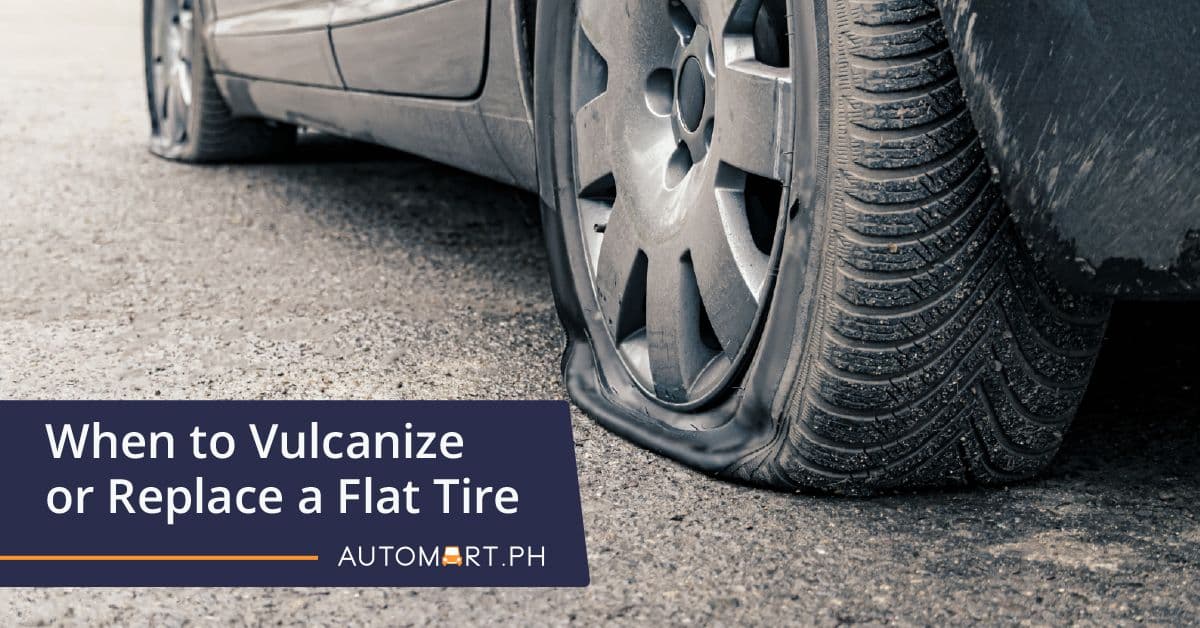
Flat Tire 101: When to Vulcanize or Replace a Punctured Tire
Updated on January 09 2026
Dealing with a flat tire can be a colossal pain. Most tire punctures are easily repairable by the nearest vulcanizing shop. However, there are instances when a puncture is terrible enough to merit a tire replacement.
If you encounter a tire puncture, the general rule is to park the vehicle and change the flat tire with a spare. It's better if there's a vulcanizing shop nearby, but what do you do if the technician says your flat tire is beyond repair?

Remember that not all tire punctures are repairable. Here are some tips to help you determine when to vulcanize or replace a punctured tire.
When to Vulcanize or Repair a Flat Tire
Not all tire punctures are the same. Some are small, but others are huge. Some punctures may penetrate the sidewall, and some will bury themselves within the tread surface. Your tire can be safely vulcanized if the following conditions hold true:
- The tire is repairable if the puncture does not measure more than a quarter of an inch (1/4-inches).
- You can vulcanize the tire if the puncture is within the surface patch, the crown area, or within the tire's prescribed "puncture repair area."

- The tire can be vulcanized if the puncture does not overlap old repair patches or if the damaged area is not directly across other holes.
- If the tire has multiple holes, it is safe to vulcanize as long as the punctures are at least 16-inches apart.
When to Replace a Punctured Tire
Nail holes are easy to repair. But if your tire got a puncture from anything other than a small nail (like a two-inch bolt, for example), it may be time to replace the tire.
- It is better to replace the tire if the puncture or hole is bigger than ¼ of an inch.
- Replace the tire if the damage or hole is on the tire sidewall.
- If the tire has massive cuts or if you notice signs of tread separation due to a crash or accident, it is better to replace the tire.
Is it okay to use tire sealants?
Yes. In the absence of a spare tire, pumping the flat tire with sealants and emergency inflators could give you enough time to drive to the nearest tire repair center or vulcanizing shop. But then again, tire sealants will not eliminate the problem and are ineffective against severe tire punctures.
Is it safe to use a tire plug or tire patch?
Similar to tire sealants, a tire plug or tire patch is only a quick-fix solution. Tire plugs may not offer a permanent seal and may fail without warning.

If you have to use a tire plug, make sure to have the tire checked at the soonest possible time to undergo proper repair. Tire plugs and tire patches are good to have in an emergency, but they do not offer a permanent fix to most tire punctures.
Are sidewall bulges or bubbles repairable?
Curb impacts, potholes, or other road hazards could cause those nasty bulges or bubbles on your tire's sidewall. Unfortunately, sidewall bulges (and sidewall punctures) are not repairable.

And even though you can still drive the car, it is not safe to do so. If you find that your tire has bulges or indentations on the sidewall, it is better to replace the tire.
Tire Safety Tips
Here are a few more tire safety tips to keep in mind:
- Maintain proper tire inflation at all times. Did you know that driving with properly inflated tires will improve fuel economy by up to 3.3-percent? Keep your tire pressure within 30 to 32 psi, or check the owner’s manual to determine the correct tire pressure for your vehicle.
- Avoid driving with bald or worn-out tires. Bald tires are not only unsafe, but they offer zero protection against punctures.
- Maintain the proper alignment. Worn-out suspension or steering components will affect the alignment of your vehicle. Improper alignment can cause premature tire wear, or it can cause your car to pull to one side (may kabig).
- Avoid overloading your vehicle.
- Visually inspect the tires at least once a week or every time you fill-up with fuel.
- Rotate the tires every 10,000 kilometers or as prescribed by the owner’s manual.
Conclusion
Remember that tires are responsible for keeping your vehicle on the road. If you have a puncture, bring your car to the nearest service center for professional advice.